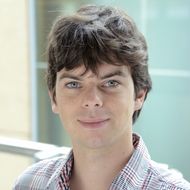Nature Communications Journal Publishes a Study by Russian Scholars Involving HSE MIEM Students

Biologists and mathematicians from HSE University, Skoltech and the RAS Kharkevich Institute have studied the spread of COVID-19 in Russia. The main part of the study was completed in late June, but until October, the team was working with data following the reviewers’ recommendations. The paper was published on January 28, 2021 in the journal Nature Communications. MIEM students spoke about their contribution to the research.
The Essence of the Study
A team of researchers from HSE University and Skoltech joined experts from the Smorodintsev Research Institute of Influenza in St. Petersburg and the Kharkevich Institute to carry out a study aimed at determining when the pandemic started in Russia and where the virus came from. They compared 211 coronavirus mutations from patients in 25 Russian regions and used them to build evolutionary trees of the virus. They discovered that SARS-SoV-2 was brought to Russia from Europe between late February and early March 2020. The first case of its transmission inside the country happened no earlier than March 11, 2020.
MIEM Students’ Work in the Research
Vadim Spirin and Nikita Shvyrev, second-year students of Applied Mathematics, work as research interns at the HSE International Laboratory of Statistical and Computational Genomics. Supervised by Vladimir Shchur, the Lab’s director, the students joined the research project in late April 2020. SARS-CoV-2 had only just appeared at the time, and there was almost no data on it, which made it particularly interesting for them to take on this project.
The students evaluated different parameters of coronavirus spreading at Vreden Hospital in St. Petersburg, where over 700 people were locked down in a quarantine for a month and over 400 of them were infected. The hospital provided a vast amount of unique data on the infected patients for the study, including the results of the virus RNA sequencing in these patients. The job was done in several stages. At first, the students sorted out the necessary software, read scholarly papers on similar tasks and looked at different models of virus distribution. Then, they applied this knowledge to solve their tasks.

Vadim Spirin,
research intern at the HSE International Laboratory of Statistical and Computational Genomics
We understood that it was important not to make a mess at the initial stage, so we listened to Professor Shchur carefully. Our task was to quickly find the necessary information for research progress and study papers with similar studies in order to take advantage of other scholars’ experience. Most skills that we needed for the job we mastered in the process of doing it. I learned to work with BEAST2, to quickly scan papers for necessary information, and to work with big information volumes in general.
To study the data, the researchers used BEAST2 pack, especially the Birth–Death skyline model. BEAST2 is a program that helps to build a distribution tree, as well as to calculate the start of virus spreading, the speed of virus mutations, and many other parameters based on the virus’s nucleotide sequences. In addition, they used software such as FigTree, which allows different presentations of the results to be created in order to see the trees, and Tracer to see the calculated parameters. The students used BEAST2 pack on the HSE supercomputer to speed up their calculations.

Nikita Shvyrev,
research intern at the HSE International Laboratory of Statistical and Computational Genomics
I am completely satisfied with what we have done. Thanks to my work on the project, I met a lot of professionals in this area and saw what real project work looks like. The most difficult thing was not to miss classes and to prepare for exams, since all I wanted to do was work on the research 24/7.
While the working pace was extremely rapid for the students, the research turned out to be thrilling, and thanks to their participation in it, they now have a clearer vision of their goals and priorities. Vadim Spirin admits that when he was entering the university he thought he only had to learn Python programming language. But as he started working on projects, he understood that its extreme deficiencies for high-quality work.
‘I have to learn to work with Cython, git, bash-scripts and С++/С. And even this may not be enough, since I may need knowledge in other areas, as well as knowledge of Python and C++/C libraries, in order to create more efficient algorithms,’ the student said. This means they now have a lot of tasks for the future.

Vladimir Shchur,
Head of the HSE International Laboratory of Statistical and Computational Genomics
I like working together with students on research projects. While I formulate the task for them and try to express myself in a comprehensible way, I start seeing the project details much more clearly. I also love it when students ask me questions. They often admit that they are afraid to appear stupid. But actually, asking questions is their primary responsibility. Someone who doesn’t know and doesn’t understand anything can’t ask questions. Furthermore, no one can know everything, and only those who ask can grow and develop. A good question from a student sometimes allows me to look at the problem from a new perspective and realize that I had missed something or mistakenly thought it was obvious.
The article was prepared by Valeria Nemnaya, second-year student at MIEM HSE
See also:
HSE Biologists Explain Mechanism behind Coronavirus Evolution
A team of researchers, including scientists of the HSE Faculty of Biology and Biotechnology, have analysed the evolutionary path of the coronavirus from the Wuhan variant to Omicron. Their findings indicate that many genomic mutations in SARS-CoV-2 are shaped by processes occurring in the intestines and lungs, where the virus acquires the ability to evade the inhibitory effects of microRNA molecules. The study findings have been published in the Journal of Medical Virology.
Russian Researchers Explain Origins of Dangerous Coronavirus Variants
HSE researchers, in collaboration with their colleagues from Skoltech and the Central Research Institute for Epidemiology, have uncovered the mechanisms behind the emergence of new and dangerous coronavirus variants, such as Alpha, Delta, Omicron, and others. They have discovered that the likelihood of a substitution occurring at a specific site of the SARS-CoV-2 genome is dependent on concordant substitutions occurring at other sites. This explains why new and more contagious variants of the virus can emerge unexpectedly and differ significantly from those that were previously circulating. The study’s findings have been published in eLife.
HSE Biologists Prepare Strategy for Universal COVID Test
Russian researchers have developed a strategy to create a cheap and rapid COVID-19 test based on isothermal amplification. According to their publication in Applied Biochemistry and Microbiology, use of this strategy will make it possible to create universal test systems for any of the COVID-19 variants.
People’s Values Affect Their Attitudes to COVID-19 Restrictions
HSE social and political analysts have established which value models and circumstances promote support for restrictive government policies aimed at combatting the coronavirus pandemic. The research is published in Plos One.
Model of Predator-Prey Relationship Helps Predict Spread of COVID-19
Researchers from the HSE Faculty of Economic Sciences have proposed a mathematical model that describes the course of the COVID-19 pandemic, taking into account the restrictions applied in different countries. The model will help governments make reasonable and timely decisions on introducing or lifting restrictions. The paper was published in Eurasian Economic Review.
HSE University Classes to Be Held On Site for All Students
Classes in the new academic year will take place on site for students of all HSE University campuses. Existing COVID safety precautions will remain in effect.
Russian Scientists Investigate the Immune Response to SARS-CoV-2 Variants
HSE University researchers assessed the effectiveness of the T-cell immune response to 11 variants of SARS-CoV-2. Their findings have been published in Nucleic Acids Research.
First-year Students Will Be Able to Get COVID Shots at HSE University
The new regulations ‘On the Organization of Studies for the 2021/2022 Academic Year’ feature in detail what will change for first-year students in the new academic year. HSE University will be organizing a vaccination drive in September for students aged 18 and over who are unvaccinated. Younger students will be eligible for vaccination once they turn 18.
New Safety Measures to Be Introduced at HSE University
Starting September 1, 2021, HSE University-Moscow is introducing new safety policies on campus to prevent the spread of COVID-19. They apply to students over 18 years old who have not had COVID during the last six months, have not been vaccinated (with a Russian or a foreign vaccine), nor have a medical exemption from vaccination. Free vaccination will be available on campus to all arriving students.
HSE University Creates the Viral Genealogy Simulator to Model the Spread of COVID-19
Researchers of HSE Tikhonov Moscow Institute of Electronics and Mathematics (MIEM), in cooperation with their colleagues from the University of California, Santa Cruz (UCSC), and The European Bioinformatics Institute (EMBL-EBI), have developed software to model the spread of the COVID-19 global pandemic. This is the world’s fastest Viral Genealogy Simulator (VGsim). For more details about this scalable simulator, read the reprint on medRxiv. The code is freely available at GitHub.


